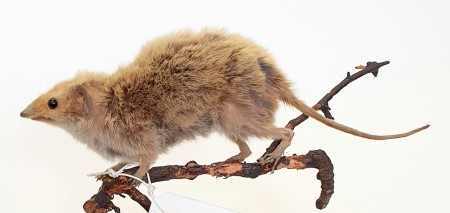Last week I gave you this fuzzy critter to have a go at identifying:

As I suspected, it proved to be tricky – small mammal taxidermy tends to be difficult, especially when it’s old, faded and a species that isn’t familar to many people. This specimen is a great example of that.
I’d love to be able to give you some clues for identification, but if I’m honest few of the distinguishing features of this species are visible (sorry!). The distinguishing features are apparently: white eye-ring (no sign thanks to fading), gray-brown fur flecked with white hairs (again it’s too faded), and a short tapering tail (just about).
This is a Dibbler or Parantechinus apicalis (Gray, 1842), which is also known as a Freckled Phascogale, Freckled Antechinus or Speckled Marsupial Mouse due to it’s flecked appearance (when it’s not faded…). Of all the comments I think Goatlips came closest with a suggestion of Antechinus, which is the genus that this species used to be included in.
These tiny marsupial carnivores feed on a surprisingly wide variety of animals, including mice, birds and lizards.
The Dibbler was declared extinct just one year after this particular specimen came to the Dead Zoo in 1883, but a couple of populations were later found in Western Australia. They’re still endangered and have a very small range, largely limited to small offshore islands where introduced predators like cats and foxes haven’t managed to spread – yet.

Thanks for taking time for a dibbler (Parantechinus apicalis) write-up, Mr.V!
Sniffed around the phascogales, but my first strong contender was the antechinuses. But it looked a bit big, even for a dusky antechinus (Antechinus swainsonii), or the black-tailed antechinus (Antechinus arktos) – seems the Internet is obsessed with the latter’s sex life. So, I had to go for the golden bandicoot (Isoodon auratus) – and had to hope the fused toes on the hind feet had shrivelled up and become unfused with age, somehow.
To make excuses for myself, the Dead Zoo’s specimen is fairly tricky to make a dibbler ID from, because of the bald tail, and golden fur, and also because it’s probably the biggest dibbler ever caught!
Plus, the marsupial list I found omitted its parantechinus genus completely! 😅:
https://www.researchgate.net/figure/Angular-process-form-plotted-onto-a-marsupial-phylogeny-based-on-Luckett-1994-for_fig1_233608151
So this is where CMOT Dibbler came from. Well, well, well…
The dibble you say! Thanks, Paolo, it was interesting, but speckletacularly unfair.
Er, turn that “unfair” into “tricky.”
Thanks, Paolo!
To help us figure out where we went wrong or right, could you give us the size of this specimen?
It’s about 18cm in total including the tail.
Thanks!